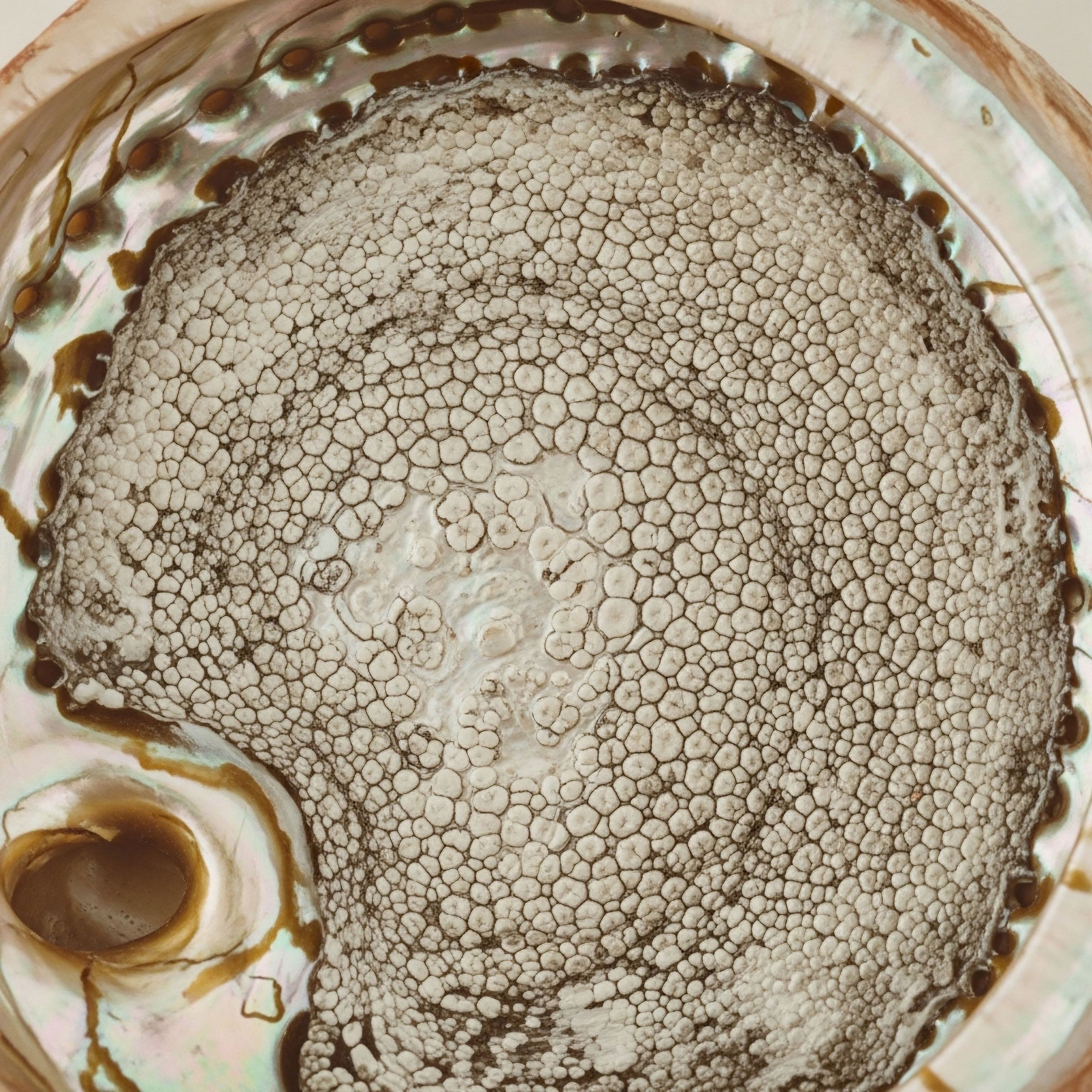

Fundamentals
Have you found yourself navigating days feeling perpetually drained, as if a vital spark has dimmed within you? Perhaps the mornings arrive with a lingering fog, and the energy you once relied upon seems elusive. Many individuals experience a profound sense of disconnect from their former vitality, often attributing it to the relentless pace of modern life. This pervasive weariness, a persistent companion for countless people, frequently stems from an often-overlooked yet deeply impactful factor ∞ chronic sleep debt.
The body operates as an intricate network of communication systems, with the endocrine system serving as its primary internal messaging service. This sophisticated network comprises glands that produce and release hormones, which act as chemical messengers. These messengers travel through the bloodstream, relaying instructions to various organs and tissues, orchestrating everything from metabolism and mood to growth and reproductive function. When this delicate balance is disrupted, the ripple effects can be felt across every aspect of daily existence.
Chronic sleep deprivation, a state where the body consistently receives less restorative sleep than it requires, imposes a significant burden on this hormonal communication system. It is not merely about feeling tired; it represents a physiological stressor that can profoundly alter the production, release, and sensitivity of various hormones.
Consider the body’s internal clock, the circadian rhythm, which is meticulously synchronized by light and darkness. Sleep is a cornerstone of this rhythm, and its consistent disruption sends confusing signals throughout the endocrine network.
Chronic sleep debt acts as a physiological stressor, significantly altering the body’s hormonal communication system.
When sleep is consistently inadequate, the body perceives this as a state of chronic stress. This perception triggers a cascade of adaptive responses, many of which involve the endocrine system. For instance, the hypothalamic-pituitary-adrenal (HPA) axis, often termed the body’s stress response system, becomes hyperactive.
This leads to an elevated and sustained release of cortisol, the primary stress hormone. While cortisol is essential for managing acute stress, its prolonged elevation can have detrimental effects on numerous bodily functions, including metabolic regulation and immune response.
The impact extends beyond stress hormones. Sleep plays a pivotal role in the regulation of hormones that govern appetite and satiety. Leptin, a hormone that signals fullness, typically rises during sleep, while ghrelin, which stimulates hunger, decreases. When sleep is insufficient, this pattern reverses ∞ ghrelin levels increase, and leptin levels decrease.
This hormonal imbalance can contribute to increased appetite, cravings for calorie-dense foods, and a greater propensity for weight gain, creating a challenging cycle for individuals striving for metabolic wellness.

The Endocrine System’s Sleep Connection
The intricate relationship between sleep and endocrine function is a testament to the body’s interconnectedness. Sleep is not a passive state; it is an active period of repair, restoration, and hormonal recalibration. During deep sleep stages, for example, the body releases growth hormone, essential for tissue repair, muscle building, and fat metabolism. A lack of sufficient deep sleep can therefore compromise these vital restorative processes, impacting physical recovery and body composition.
Furthermore, the delicate balance of reproductive hormones is also susceptible to sleep disruption. In both men and women, chronic sleep debt can influence the production of sex hormones like testosterone and estrogen. For men, inadequate sleep has been linked to lower testosterone levels, which can manifest as reduced energy, decreased libido, and changes in mood. Women may experience irregularities in their menstrual cycles or exacerbated symptoms during perimenopause due to hormonal fluctuations influenced by poor sleep patterns.

How Sleep Debt Disrupts Hormonal Rhythms
The body’s hormonal output follows distinct daily rhythms, often referred to as circadian rhythms. Cortisol, for instance, typically peaks in the morning to help us wake up and gradually declines throughout the day, reaching its lowest point at night. Melatonin, the sleep-inducing hormone, follows an inverse pattern, rising in the evening to prepare the body for rest.
Chronic sleep debt can flatten these natural hormonal curves, leading to a state where the body struggles to differentiate between day and night, rest and activity.
This desynchronization can result in a constant state of low-grade physiological stress, making it harder to fall asleep, stay asleep, and achieve truly restorative rest. The consequence is a vicious cycle ∞ poor sleep disrupts hormones, and disrupted hormones make quality sleep even more challenging to attain. Understanding this fundamental interplay is the first step toward reclaiming control over one’s biological systems and restoring a sense of vitality.


Intermediate
While the foundational understanding of sleep’s impact on endocrine function is clear, the question remains ∞ can lifestyle modifications alone fully restore hormonal balance after prolonged sleep debt? For many, simple adjustments to sleep hygiene represent a powerful initial step.
Establishing a consistent sleep schedule, optimizing the sleep environment, and limiting exposure to blue light before bed can certainly aid in recalibrating circadian rhythms. However, for individuals with significant, long-standing sleep debt and its resultant hormonal dysregulation, these measures, while beneficial, may not be sufficient to fully reverse the physiological adaptations that have taken hold.
The body, in its wisdom, adapts to chronic stressors. When sleep debt persists, the endocrine system may establish a new, suboptimal equilibrium. This is where a more targeted, clinically informed approach becomes essential. Lifestyle modifications lay a critical groundwork, but sometimes, specific biochemical recalibration is needed to guide the system back to optimal function. This often involves considering protocols that directly address hormonal deficiencies or imbalances that have become entrenched.

Targeted Hormonal Optimization Protocols
For individuals experiencing symptoms of hormonal imbalance that persist despite diligent lifestyle efforts, a deeper exploration into targeted hormonal optimization protocols may be warranted. These protocols aim to restore specific hormone levels to their physiological ranges, thereby supporting the body’s overall endocrine health and metabolic function.

Testosterone Replacement Therapy for Men
Men experiencing symptoms such as persistent fatigue, reduced libido, decreased muscle mass, and mood changes, particularly after a history of chronic sleep debt, may find these symptoms linked to suboptimal testosterone levels. Testosterone Replacement Therapy (TRT) is a protocol designed to address this. A standard approach often involves weekly intramuscular injections of Testosterone Cypionate (200mg/ml). This exogenous testosterone helps to restore circulating levels, alleviating many of the associated symptoms.
To maintain natural testicular function and fertility, especially for younger men or those desiring future fertility, Gonadorelin is frequently included. This peptide is administered via subcutaneous injections, typically twice weekly, to stimulate the pituitary gland to produce luteinizing hormone (LH) and follicle-stimulating hormone (FSH), which in turn support endogenous testosterone production.
Additionally, to manage potential side effects such as the conversion of testosterone to estrogen, an Anastrozole oral tablet is often prescribed twice weekly. This medication acts as an aromatase inhibitor, reducing estrogen levels. In some cases, Enclomiphene may also be incorporated to further support LH and FSH levels, promoting natural testicular output.

Testosterone Replacement Therapy for Women
Women, too, can experience the impact of suboptimal testosterone levels, manifesting as irregular cycles, mood shifts, hot flashes, and diminished libido, particularly during pre-menopausal, peri-menopausal, and post-menopausal phases. For these individuals, specific protocols are tailored to their unique physiological needs. Testosterone Cypionate is typically administered weekly via subcutaneous injection, with dosages ranging from 10 ∞ 20 units (0.1 ∞ 0.2ml).
The inclusion of Progesterone is often based on the woman’s menopausal status, playing a vital role in balancing estrogen and supporting uterine health. Another option for sustained testosterone delivery is Pellet Therapy, where long-acting testosterone pellets are inserted subcutaneously. When appropriate, Anastrozole may also be used in women to manage estrogen conversion, though typically at lower doses than for men.

Growth Hormone Peptide Therapy
Beyond sex hormones, chronic sleep debt can also impair the body’s natural production of growth hormone. For active adults and athletes seeking anti-aging benefits, muscle gain, fat loss, and improved sleep quality, Growth Hormone Peptide Therapy offers a compelling avenue. These peptides work by stimulating the body’s own production and release of growth hormone, rather than introducing exogenous growth hormone directly.
Key peptides in this category include:
- Sermorelin ∞ A growth hormone-releasing hormone (GHRH) analog that stimulates the pituitary gland.
- Ipamorelin / CJC-1295 ∞ A combination often used to provide a sustained release of growth hormone. Ipamorelin is a growth hormone secretagogue, while CJC-1295 is a GHRH analog.
- Tesamorelin ∞ Another GHRH analog, particularly noted for its effects on reducing visceral fat.
- Hexarelin ∞ A potent growth hormone secretagogue that also has cardiovascular benefits.
- MK-677 ∞ An oral growth hormone secretagogue that can increase growth hormone and IGF-1 levels.
These peptides can help restore the restorative processes that are often compromised by chronic sleep debt, supporting tissue repair, metabolic efficiency, and overall vitality.
Targeted hormonal optimization protocols can provide essential biochemical recalibration when lifestyle modifications alone are insufficient to restore endocrine balance.

Other Targeted Peptides for Systemic Support
The impact of chronic sleep debt extends to various physiological systems, and specific peptides can offer targeted support for areas often affected.
- PT-141 ∞ This peptide is utilized for sexual health, addressing concerns such as low libido that can be exacerbated by hormonal imbalances stemming from sleep deprivation. It acts on melanocortin receptors in the brain to influence sexual desire.
- Pentadeca Arginate (PDA) ∞ This peptide is gaining recognition for its role in tissue repair, healing processes, and modulating inflammation. Chronic sleep debt often leads to increased systemic inflammation and impaired recovery, making PDA a valuable tool in supporting the body’s restorative capacities.
These clinical protocols, when applied judiciously and under expert guidance, serve as powerful tools to assist the body in regaining its hormonal equilibrium. They do not replace the fundamental importance of lifestyle modifications, but rather complement them, providing the necessary biochemical support to overcome entrenched dysregulation.

Comparing Hormonal Support Strategies
Understanding the distinct applications of various hormonal support strategies is essential for personalized wellness.
| Strategy | Primary Mechanism | Targeted Conditions | Common Administration |
|---|---|---|---|
| Testosterone Cypionate (Men) | Exogenous hormone replacement | Low testosterone, hypogonadism | Weekly intramuscular injection |
| Gonadorelin (Men) | Stimulates endogenous hormone production | Fertility preservation, testicular function | 2x/week subcutaneous injection |
| Anastrozole (Men/Women) | Aromatase inhibition | Estrogen management | 2x/week oral tablet |
| Testosterone Cypionate (Women) | Exogenous hormone replacement | Low testosterone symptoms (women) | Weekly subcutaneous injection |
| Progesterone (Women) | Hormone balance, uterine health | Menopausal symptoms, cycle regulation | Oral, topical, or vaginal |
| Sermorelin/Ipamorelin/CJC-1295 | Stimulates natural growth hormone release | Anti-aging, muscle gain, fat loss, sleep improvement | Subcutaneous injection |
| PT-141 | Melanocortin receptor activation | Sexual dysfunction, low libido | Subcutaneous injection |
| Pentadeca Arginate (PDA) | Tissue repair, anti-inflammatory | Healing, inflammation, recovery | Subcutaneous injection |
These interventions are not quick fixes; they are components of a comprehensive strategy aimed at restoring systemic balance. The goal is to assist the body in re-establishing its optimal internal communication, allowing individuals to reclaim their energy and function.


Academic
The proposition that lifestyle modifications alone can fully restore endocrine function after chronic sleep debt warrants a rigorous examination from a systems-biology perspective. While the body possesses remarkable adaptive capacities, prolonged physiological stressors, such as chronic sleep deprivation, can induce persistent epigenetic and cellular changes that transcend simple behavioral adjustments. The endocrine system, with its intricate feedback loops and hierarchical control, represents a prime example of a system where chronic perturbation can lead to entrenched dysregulation.
Consider the Hypothalamic-Pituitary-Gonadal (HPG) axis, a central regulatory pathway for reproductive and metabolic health. Chronic sleep restriction has been shown to directly impact the pulsatile release of Gonadotropin-Releasing Hormone (GnRH) from the hypothalamus. This disruption, in turn, affects the pituitary’s secretion of LH and FSH, ultimately compromising gonadal steroidogenesis in both sexes.
Research indicates that even a single night of severe sleep restriction can significantly reduce testosterone levels in healthy young men, highlighting the acute sensitivity of this axis. Prolonged sleep debt can lead to a sustained suppression of the HPG axis, creating a state of functional hypogonadism that lifestyle changes alone may struggle to fully reverse.
Chronic sleep restriction can induce persistent epigenetic and cellular changes, leading to entrenched endocrine dysregulation.

Metabolic Pathways and Hormonal Interplay
The interconnectedness of sleep, metabolism, and hormonal health extends deeply into cellular energetics. Chronic sleep deprivation is a recognized risk factor for insulin resistance and type 2 diabetes. This is not merely due to altered appetite hormones; it involves direct effects on insulin sensitivity at the cellular level.
Studies have demonstrated that even short-term sleep restriction can decrease whole-body insulin sensitivity by a significant margin, impacting glucose uptake in peripheral tissues. This metabolic dysfunction creates a vicious cycle, as impaired glucose regulation can further disrupt hormonal signaling, including that of thyroid hormones and growth hormone.
The sympathetic nervous system (SNS) also becomes chronically activated with sleep debt, leading to elevated catecholamine levels. This sustained sympathetic tone can directly inhibit insulin secretion from pancreatic beta cells and promote hepatic glucose production, further exacerbating insulin resistance. The constant state of physiological alert, driven by sleep deprivation, diverts metabolic resources away from restorative processes and towards a ‘fight or flight’ state, fundamentally altering the body’s energy partitioning.

Neurotransmitter Function and Endocrine Control
The brain’s neurotransmitter systems are inextricably linked to both sleep regulation and endocrine control. Sleep architecture, particularly the duration and quality of slow-wave sleep (SWS) and rapid eye movement (REM) sleep, is influenced by neurotransmitters such as serotonin, dopamine, and norepinephrine. Chronic sleep debt alters the synthesis, release, and receptor sensitivity of these crucial neurochemicals.
For instance, dopamine pathways, which are integral to motivation, reward, and the regulation of the HPG axis, can be dysregulated by insufficient sleep. This can contribute to the anhedonia and reduced libido often reported by individuals with chronic fatigue. Similarly, alterations in serotonin pathways can impact mood regulation and appetite control, further complicating the clinical picture.
The brain’s capacity to orchestrate precise hormonal pulses, such as the nocturnal surge of growth hormone, relies on the integrity of these neurotransmitter systems, which are compromised by sleep deprivation.

Can Lifestyle Modifications Fully Restore Endocrine Function?
While lifestyle interventions ∞ such as consistent sleep hygiene, regular physical activity, and a nutrient-dense diet ∞ are absolutely foundational, their capacity to fully reverse deeply entrenched endocrine dysregulation following chronic sleep debt is often limited. The body’s compensatory mechanisms, while initially adaptive, can become maladaptive over time, leading to a new homeostatic set point that is suboptimal.
For example, while improving sleep can modestly increase testosterone levels, it may not be sufficient to restore them to optimal physiological ranges in men with significant, clinically defined hypogonadism that has developed over years of sleep deprivation and other stressors. In such cases, targeted biochemical recalibration, such as Testosterone Replacement Therapy (TRT), becomes a clinically indicated intervention to restore hormonal milieu and alleviate debilitating symptoms.
Similarly, for women experiencing persistent hormonal imbalances related to perimenopause or post-menopause, even with improved sleep, the physiological decline in ovarian hormone production may necessitate specific hormonal optimization protocols. These protocols are designed to provide the body with the precise hormonal signals it can no longer adequately produce, thereby supporting systemic function and quality of life.

The Role of Peptides in Endocrine Recalibration
Peptide therapies offer a sophisticated approach to endocrine recalibration by leveraging the body’s endogenous signaling pathways. Unlike direct hormone replacement, many peptides act as secretagogues, stimulating the body’s own glands to produce and release hormones. This approach can be particularly valuable in situations where the feedback loops are disrupted but the underlying glandular capacity is still present.
For instance, Growth Hormone-Releasing Peptides (GHRPs) like Ipamorelin or CJC-1295 stimulate the pituitary gland to release growth hormone in a more physiological, pulsatile manner. This can help restore the nocturnal growth hormone surge often blunted by chronic sleep debt, supporting cellular repair, metabolic health, and body composition. The precision of peptide signaling allows for a more nuanced intervention, aiming to restore the body’s innate regulatory intelligence rather than simply replacing a missing hormone.
The long-term effects of chronic sleep debt on the endocrine system are complex and multifaceted, involving epigenetic modifications, altered receptor sensitivity, and persistent changes in neuroendocrine feedback loops. While lifestyle interventions are indispensable for overall health and can mitigate some of the damage, for many individuals, achieving full endocrine restoration requires a more comprehensive strategy that may include targeted hormonal optimization protocols.
These interventions, guided by precise clinical assessment, serve to re-establish the delicate balance that chronic sleep debt has disrupted, allowing individuals to reclaim their full physiological potential.
| Hormone/Axis | Impact of Chronic Sleep Debt | Potential for Lifestyle Restoration Alone | Clinical Intervention Consideration |
|---|---|---|---|
| Cortisol (HPA Axis) | Elevated basal levels, flattened diurnal rhythm | Partial improvement with consistent sleep hygiene | Stress management protocols, adaptogens (adjunctive) |
| Testosterone (HPG Axis) | Reduced pulsatility, lower total/free levels | Modest increase, often insufficient for clinical hypogonadism | Testosterone Replacement Therapy (TRT), Gonadorelin, Enclomiphene |
| Growth Hormone | Blunted nocturnal surge, reduced IGF-1 | Some improvement with deep sleep optimization | Growth Hormone Peptides (Sermorelin, Ipamorelin/CJC-1295) |
| Insulin Sensitivity | Decreased peripheral sensitivity, increased resistance | Significant improvement with diet/exercise/sleep | Metformin (if clinically indicated), targeted nutritional support |
| Leptin/Ghrelin | Increased ghrelin, decreased leptin (hunger/satiety dysregulation) | Good potential for restoration with consistent sleep | Dietary counseling, appetite modulators (rarely) |
This table illustrates that while lifestyle modifications are foundational, the degree of endocrine restoration they can achieve varies depending on the specific hormone and the extent of the dysregulation. For persistent and clinically significant imbalances, a personalized approach integrating targeted therapies becomes a necessity.

References
- Leproult, Rachel, and Eve Van Cauter. “Effect of 1 Week of Sleep Restriction on Testosterone Levels in Young Healthy Men.” JAMA, vol. 305, no. 21, 2011, pp. 2173-2174.
- Spiegel, Karine, et al. “Impact of Sleep Debt on Metabolic and Endocrine Function.” The Lancet, vol. 354, no. 9188, 1999, pp. 1435-1439.
- Vgontzas, Alexandros N. et al. “Sleep Deprivation and Hormonal Secretion.” Journal of Clinical Endocrinology & Metabolism, vol. 86, no. 11, 2001, pp. 5123-5127.
- Cauter, Eve Van, and Kenneth S. Polonsky. “Sleep and Endocrine Rhythms.” Endocrine Reviews, vol. 26, no. 5, 2005, pp. 717-738.
- Guyton, Arthur C. and John E. Hall. Textbook of Medical Physiology. 13th ed. Elsevier, 2016.
- Boron, Walter F. and Emile L. Boulpaep. Medical Physiology. 3rd ed. Elsevier, 2017.
- The Endocrine Society. Clinical Practice Guidelines. 2023.
- American Association of Clinical Endocrinologists (AACE). Clinical Practice Guidelines. 2023.

Reflection
As you consider the intricate dance between sleep and your body’s internal messaging system, perhaps a new understanding of your own experiences begins to take shape. The journey toward reclaiming vitality is deeply personal, reflecting the unique symphony of your biological systems.
Recognizing the profound impact of chronic sleep debt on hormonal balance is not an endpoint, but rather a significant beginning. It is an invitation to look beyond surface-level symptoms and to truly listen to the subtle signals your body transmits.
This exploration into the depths of endocrine function, metabolic pathways, and targeted clinical protocols serves as a compass, guiding you toward a more informed and proactive stance on your health. The knowledge gained here is a powerful ally, empowering you to engage in meaningful conversations with healthcare professionals and to advocate for a personalized path forward. Your well-being is a dynamic process, and understanding its underlying mechanisms allows for intentional, precise recalibration.
The path to optimal function is rarely a linear one, and it often requires a blend of foundational lifestyle adjustments and, when indicated, specific biochemical support. The goal is always to restore the body’s innate capacity for balance and self-regulation, allowing you to experience a renewed sense of energy, clarity, and overall well-being. This understanding is the first step in a collaborative effort to unlock your full physiological potential.



